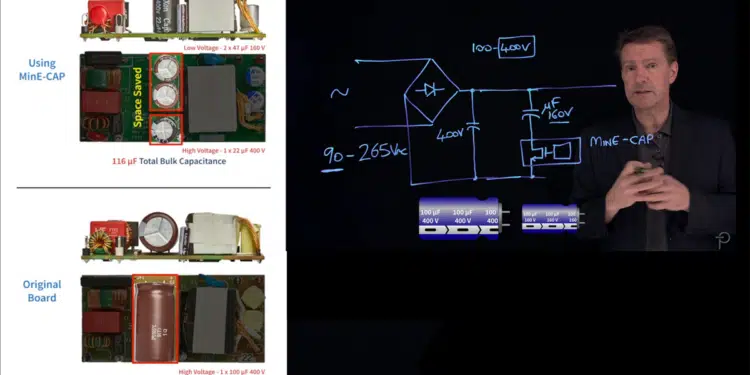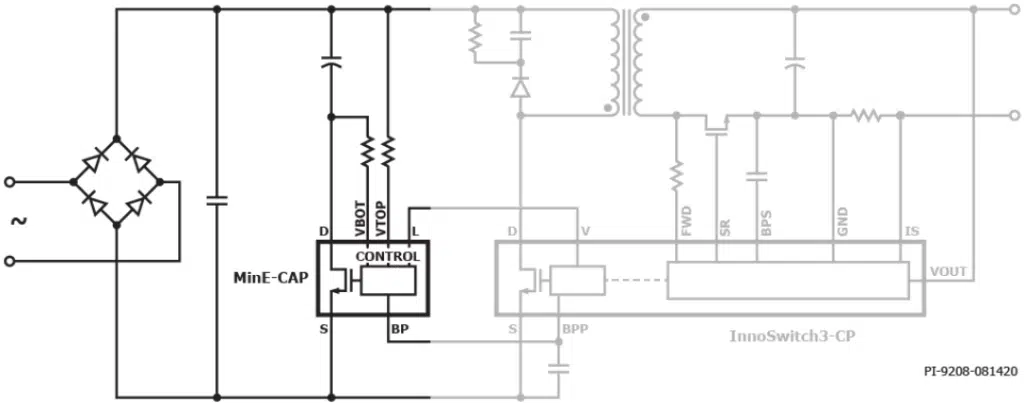Power Integrations has developed a novel way to shrink the size of universal input AC-DC converters without increasing switching frequency. The MinE-CAP IC halves the size of high-voltage bulk electrolytic capacitors, resulting in up to 40% adapter size reduction while increasing system efficiency in chargers up to 65 W.
Power Integrations, the leader in high-voltage integrated circuits for energy-efficient power conversion, announced the MinE-CAP™ IC for high power density, universal input AC-DC converters. By halving the size of the high-voltage bulk electrolytic capacitors required in offline power supplies, this new type of IC enables a reduction in adapter size of up to 40%. The MinE-CAP device also dramatically reduces in-rush current making NTC thermistors unnecessary, increasing system efficiency and reducing heat dissipation.
Comments Power Integrations’ product marketing director, Chris Lee: “The MinE-CAP will be a game-changer for compact chargers and adapters. Electrolytic capacitors are physically large, occupy a significant fraction of the internal volume and often constrain form factor options – particularly minimum thickness – of adapter designs. The MinE-CAP IC allows the designer to use predominantly low voltage rated capacitors for a large portion of the energy storage, which shrinks the volume of those components linearly with voltage. USB PD has driven a major market push towards small 65 W chargers and many companies have concentrated on increasing switching frequency to reduce the size of the flyback transformer. MinE-CAP provides more volume saving than doubling the switching frequency, while actually increasing system efficiency.”
The MinE-CAP leverages the small size and low RDSon of PowiGaN™ gallium nitride transistors to actively and automatically connect and disconnect segments of the bulk capacitor network depending on AC line voltage conditions. Designers using MinE-CAP select the smallest high-line rated bulk capacitor required for high AC line voltages, and allocate most of the energy storage to lower voltage capacitors that are protected by the MinE-CAP until needed at low AC line. This approach dramatically shrinks the size of input bulk capacitors without compromising output ripple, operating efficiency, or requiring redesign of the transformer.
Conventional power conversion solutions reduce power supply size by increasing switching frequency to allow the use of a smaller transformer. The innovative MinE-CAP IC achieves just as significant overall power supply size reduction while using fewer components and avoiding the challenges of higher EMI and the increased transformer/clamp dissipation challenges associated with high-frequency designs. Applications include smart mobile chargers, appliances, power tools, lighting and automotive.
Said Bhaskar Thiagaragan, Director of Power Integrations India Ltd.: “MinE-CAP ICs are excellent for all locations with wide ranging input voltages. In India we often design for voltages from 90 VAC to 350 VAC, with a generous surge de-rating above that. Engineers here often complain about the forest of expensive high-voltage capacitors required. MinE-CAP dramatically reduces the number of high-voltage storage components, and shields lower voltage capacitors from the wild mains voltage swings, substantially enhancing robustness while reducing system maintenance and product returns.































